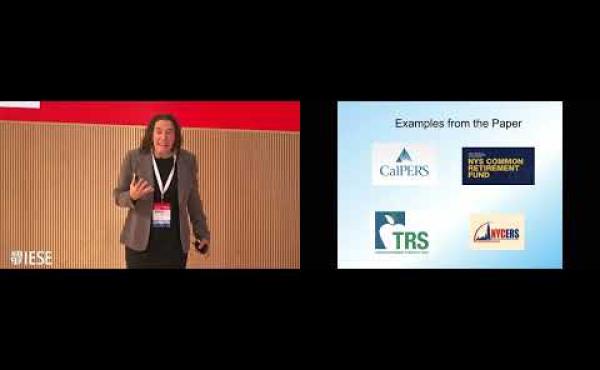
The ECGI blog is kindly supported by

The Singular Role of Public Pension Funds in Corporate Governance
Among institutional investors, public pension funds hold a uniquely public and potent position. With over $5 trillion in assets under management, these funds influence corporate governance, ESG initiatives, and economic development far beyond their nominal mandate of managing the retirement money of public employees. Yet, the prevailing legal and policy framework is anchored in the doctrine of "beneficiary primacy," which posits that fund managers must act solely in the economic interest of pension beneficiaries. In this article, we argue that beneficiary primacy fails to capture the singular structure and role of public pension funds and subjects them unduly to litigation risk. Instead, our article proposes a fundamental reconceptualization: public pension funds should be understood not as intermediaries whose managers are fiduciary-bound to serve passive beneficiaries, but as public principals imbued with public values and run in accordance with those values.
We start with an overview of the structure, investment policies, and governance initiatives of four major public pension funds. We recount the paradigm-shifting role that public pension funds have played – from pioneering socially responsible investing to serving as catalysts for governance changes that have increased management accountability through greater shareholder empowerment. We also identify developments in public pension fund engagement on ESG issues.
As we explain, although these efforts have been longstanding and extensive, they have also been controversial. Public pension funds have faced legal challenges to actions ranging from their 1975 bailout of New York City to their 2024 divestment from fossil fuels. Although courts have generally rejected these challenges, in doing so, they have reaffirmed the foundational principle of beneficiary primacy -- that fund managers have a fiduciary duty to focus exclusively on fund economic value for the benefit of the funds’ beneficiaries.
Beneficiary primacy, as we explain, is rooted in the obligations imposed on mutual funds by the Investment Advisors Act and on private pension funds by ERISA. While public pension plans are governed instead by a patchwork of state and local laws, ERISA’s exclusive benefit rule is the de facto legal standard. We argue this approach is misguided: it is unfaithful to public pension funds’ historical investing and engagement practices, and it fails to reflect critical differences between public pension funds and private funds.
The core conceptual error behind beneficiary primacy is that, unlike typical mutual fund investors, beneficiaries of public pensions are not residual claimants. Fund managers owe fiduciary duties to residual claimants because their returns are based on fund performance. But public pension beneficiaries receive fixed payments after retirement regardless of returns. Because beneficiaries are contractual claimants, fiduciary duties are inapt. The focus on beneficiaries also ignores the institutional design of public pension funds, which positions them as embodiments of public values, not vehicles to maximize beneficiary wealth.
To cure this misalignment, we argue that public pension funds should be conceptualized as principals—entities with autonomous interests shaped by legislation, democratic processes, and institutional design. Fund managers are then agents of the fund, and their duty is to represent the fund, not just its beneficiaries. This reframing aligns with how public pensions actually operate: they are governed by boards representing diverse constituencies, constrained by legislation, and politically accountable through elected officials.
This model legitimizes investing decisions that reflect public values—whether in climate-conscious portfolios, worker protection, or local economic development. It also offers doctrinal coherence by aligning fiduciary duties with institutional purpose rather than forcing conformity to a private law template.
The implications of our theory are significant. First, our approach would de-weaponize fiduciary law in ESG debates. Anti-ESG laws—like Florida’s prohibition of non-pecuniary investing, or New Hampshire’s criminalization of ESG considerations—rely on the narrow conception of fiduciary duty enshrined in beneficiary primacy to restrict public pension funds. Our model repositions decisions to constrain public pensions as political, not legal, judgments. States that want to limit or promote ESG investing should do so transparently through legislation, not via contorted interpretations of fiduciary law.
Second, our re-theorization would transform fund manager discretion. Currently, managers must justify values-aligned actions in economic terms, leading to disingenuous arguments about long-term returns. Yet it is nearly impossible to parse the pecuniary and non-pecuniary motivations underlying managers’ decisions as well as the potential economic consequences of values-based investment decisions. Under our model, fund managers need no longer defend their decisions purely in economic terms, freeing them to openly pursue public-oriented goals, while remaining accountable through the political process and legal safeguards against self-dealing and mismanagement.
Third, our model invites better alignment between public values and capital markets. Public pension funds can and should serve as democratic conduits for societal preferences in corporate governance. Their activism in shareholder voting, ESG proposals, and securities litigation has already shaped practices and norms around board accountability and corporate sustainability and transparency. Viewing them as principals solidifies their role as stewards of the public interest in the financial sector.
_______________
By Jill Fisch (University of Pennsylvania and ECGI) & Jeff Schwartz (University of Utah and ECGI)
The ECGI does not, consistent with its constitutional purpose, have a view or opinion. If you wish to respond to this article, you can submit a blog article or 'letter to the editor' by clicking here.










